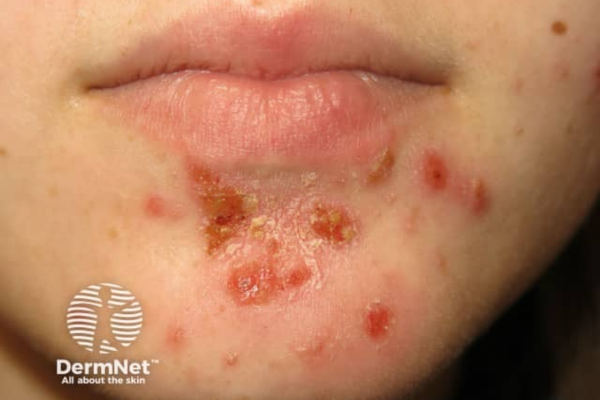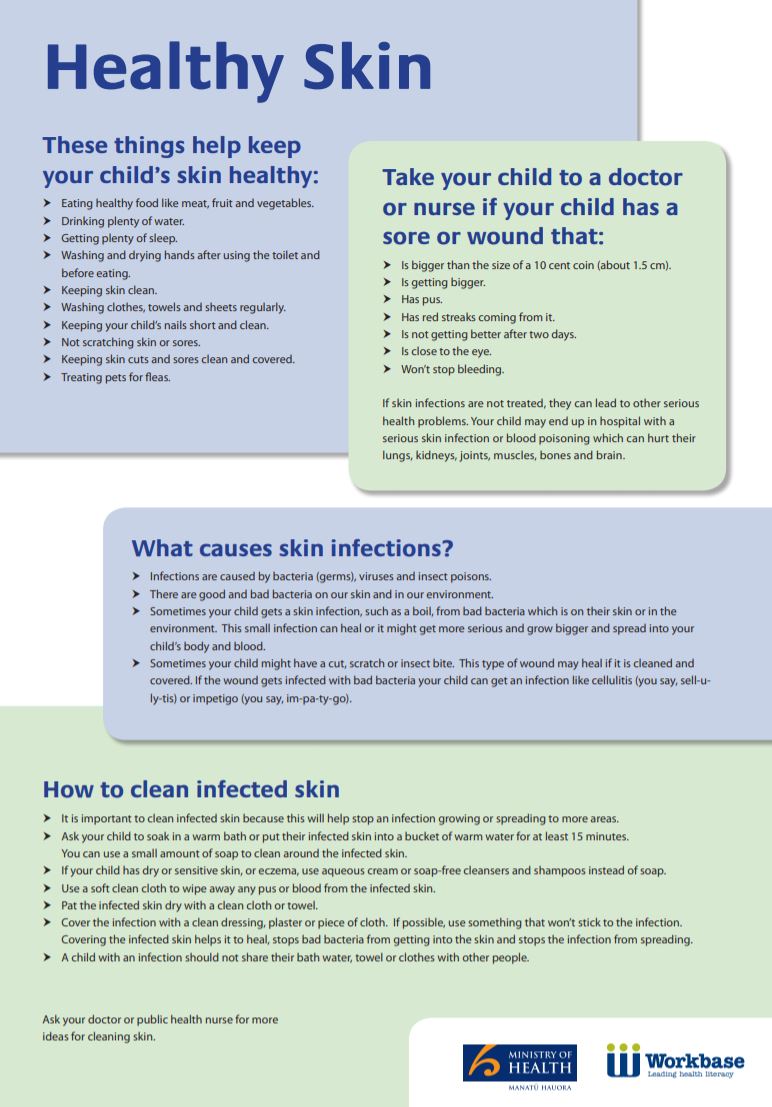Wishing everyone a safe and happy Christmas and New Year – Meri Kirihimete from the Healthify team.
School sores | Pokenga kiri whēwhē
Also known as impetigo
Key points about school sores
- School sores (pokenga kiri whēwhē) is the name used for a very common skin infection called impetigo.
- Impetigo is caused by 2 types of bacteria: Streptococcus pyogenes (strep) or Staphylococcus aureus (staph).
- It causes sores on your skin, generally on your hands and face, especially around your nose and mouth. It can also affect other areas of your body.
- It easily spreads from one person to another and is most common in children.
- Children should see a healthcare provider for assessment and treatment and should be kept away from school or daycare to avoid spread to other children.

Impetigo is a common skin infection caused by 2 types of bacteria: Streptococcus pyogenes (strep) or Staphylococcus aureus (staph). Some people carry these bacteria in their nostrils, on the skin or in the throat. The bacteria can be passed to hands and then onto other parts of your skin.
Most of the time, your skin works as a barrier that keeps bacteria out. Bacteria can live on your body without causing problems. But when there's a break in your skin (eg, a cut or graze) bacteria can enter your body. It can then grow, causing inflammation and infection.
Breaks in your skin can happen with bites (insect, animal or human) or an injury. Impetigo can also happen on healthy skin where there is no break to see.
Impetigo is most common in children. In adults it can happen because of other skin conditions. It's also more common for people with a weakened immune system to get it.
Impetigo usually starts as little blisters. These break and start to weep, usually pus or sometimes a clearer liquid. The weeping patches usually get larger, then yellow or brownish scabs form. These can burn or itch.
Impetigo can also start from any damaged skin that doesn't heal and develops a crusty scab. Sometimes it looks like a rash – it can start as a single spot, but if you scratch it, it can spread to other places. You can also get swollen glands (lymph nodes).
- Impetigo can usually be diagnosed by how it looks and a description of how it started. You can see an image below and more images if you search for impetigo on the DermNet site.(external link)
- Sometimes a skin swab is needed if it keeps coming back or doesn't get better with treatment.
- A swab is also taken if there's concern that it might be caused by an antibiotic-resistant strain of bacteria (eg, MRSA).

Image credit: DermNet NZ(external link)
Image credit: Healthify He Puna Waiora
Clean off scabs and crusts
Remove the scab or crusted area by washing with an antiseptic solution, eg, Dettol or Savlon. Follow the instructions on the packaging or ask your pharmacist for advice on how to use them. You can also remove crusts by doing the following:
- Give your child a warm bath for 20 minutes and gently wipe the crusts away with a wet towel. Wash the towel afterwards.
- Make up a mixture of half a cup of white vinegar in a litre of warm water, and lay a cloth soaked in this mix over the sores for about 10 minutes, 3 times a day. Gently wipe off the crusts.
- For more severe cases, your healthcare provider may suggest you do bleach baths(external link).
Keep the sores covered
Keep the sores clean and cover them with a watertight dressing or bandage, to prevent them spreading. Dressings and the correct tapes to hold the dressing in place can be bought from pharmacies. Put used dressings into a plastic bag and seal it before throwing it out.
Try to stop your child from scratching the sores as much as possible. Keep your child's fingernails short to prevent damage and infection from scratching. Make sure your child washes their hands with soap often, especially if they touch the sores.
Antiseptic cream
You can buy antiseptic cream at your pharmacy. Apply it to the affected areas as advised by your pharmacist – usually 2 or 3 times a day. Examples of antiseptics are povidone-iodine, hydrogen peroxide cream or chlorhexidine.
- Before applying the cream, remove the crusted area (see above).
- After applying the antiseptic, cover the sores with a dressing (see above).
- Look carefully in case there are new sores to treat.
- Remember to wash your hands with soap and water before and after applying the cream to your child's skin.
Make an appointment to see your doctor or nurse if:
- the antiseptic cream hasn’t worked after 2 days
- there's a sore bigger than a 10 cent coin
- there are many sores.
They will talk with you about continuing to treat the skin with cleaning, and may prescribe antiseptic cream or an oral antibiotic (taken by mouth).
Antibiotic liquid or capsules
If you are prescribed antibiotic liquid or capsules (also called oral antibiotics), continue taking the medicine for the full course, even if the sores look like they've healed. Oral antibiotics can sometimes have side effects. Tell your healthcare provider if you get any diarrhoea (runny poo), stomach upsets or skin rashes.
Other treatment
Sometimes your doctor may also prescribe a body wash or ointment to rub on the inside of the nostrils for the person with impetigo and other whānau members – the bacteria can hide out there and re-infect others.
School sores are highly contagious and are easily spread by touching.
To avoid the spread keep your child away from school or day care until 1 day after the start of treatment, and keep the sores completely covered with dressings.
Other ways to prevent spreading school sores to others include:
- Wash your hands with soap and dry thoroughly before and after touching the skin or sores or applying the antiseptic cream.
- Don't share towels, soap and face towels. Make sure each family member has their own.
- Wash your child's clothes, towels and bed linen separately from the rest of the family washing. Wash them in hot water and dry in the sunshine or in a hot tumble dryer. You can wash toys in a mild disinfectant.
- Put all used tissues and dressings in a rubbish bin with a lid.
- Your child should avoid swimming until all the sores have healed.
For more information and support talk to your doctor, practice nurse or your local pharmacist, or ask to speak to the public health nurse attached to the school. You can also phone Healthline free (within Aotearoa New Zealand) on 0800 611 116 for health advice.
Impetigo – school sores(external link) Kidshealth NZ
Bleach baths for skin infections(external link) DermNet NZ
Apps
Resources
Impetigo (school sores)(external link) Health Literacy NZ
Infected eczema(external link) Diana Purvis – Paediatric Dermatologist
Keeping skin healthy(external link) Health Literacy NZ
Infectious diseases(external link) A4 poster HealthEd, NZ
References
- Management of impetigo(external link) BPAC, NZ, 2021
- Impetigo(external link) Auckland Region HealthPathways, NZ, 2022
Antibiotics – choices for common infections(external link) BPAC, NZ, 2011
Management of impetigo(external link) BPAC, NZ, 2021
Apps
Brochures

Health Literacy NZ

Starship, NZ, 2005
English and te reo Māori, Chinese, Samoan, Tongan
Credits: Healthify editorial team. Healthify is brought to you by Health Navigator Charitable Trust.
Reviewed by: Dr Emma Dunning, Clinical Editor and Advisor
Last reviewed:






